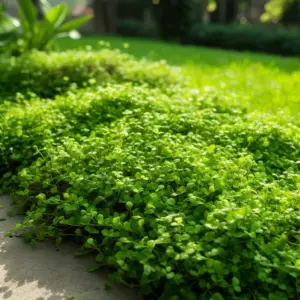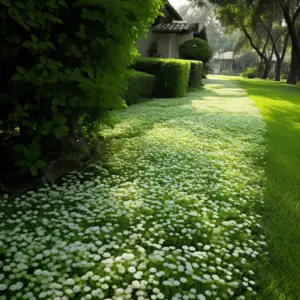Dichondra lawns is the name of a genus of small size, creeping flowering plants in the morning glory family, Convolvulaceae.
There are several species that fall into this category but in the botanical community, certain factions recognize only two Dichondra carolinensis and Dichondra repens. In other academic circles, over ten different species are recognized as members of this genus.
The defining characteristic of dichondra plants is that they are largely perennial prostrate plants with creeping stems and fairly insignificant flowering. In many places where they are found naturally, they are treated as weeds and periodically discarded through weeding or sprayed with pesticides.
Dichondra is a favorite for landscaping and many gardeners refer to the plants as lawn-leaf. Several cultivars have been developed in past decades for this ornamental purpose and with good reason.
The creeping nature of the plants makes it a suitable substitute for grass and the lush leaf growth they sustain gives your lawn a luscious appeal.
In the past, Dichondra micrantha was a favorite for lawn foliage but has since been replaced in favor of Dichondra repens.
The ‘repens’ has a fairly similar lush green appearance to Dichondra micrantha. Dichondra argentea which is also known as ‘silver falls’ for its peculiar silvery countenance is also used as lawn decor.
Table of Contents
Advantages of a Dichondra Lawn

Minimal Maintenance
Dichondra as a species is quite resilient and does well with minimal input. The plants are after all considered weeds and behave like so, growing anywhere habitable enough. The plants can withstand fairly high temperatures and survive through the winter without dying altogether.
Dichondra argentae or silver falls in particular, is an annual and does not need to be cultivated anew each season. If you are looking for a plant that can continue to grow all year round then this is the species for you.
Very Thick Undergrowth
Dichondra plants mature to 2-3 inches wide leaves and grow no taller than 8 inches. Since they are creeping plants, they create thick, lush foliage that makes it difficult to see the ground beneath.
Dichondra develops a dense, colorful carpet of undergrowth, making it a great lawn cover. Dichondra is a great lawn grass replacement.
Lush Colorful Aesthetic
Dichondra argentae has a silvery face while Dichondra repens boasts a stunning bright green. Both species produce small numerous flowers that can be green, white, or yellow.
Depending on which species you have on your lawn, your space can be a carpet of green, silver, yellow, white, or a collage of all these colors. Your lawn can have a beautiful graceful look or playful appeal at any one time.
Grows and Propagates Easily
Dichondra plants grow quickly and easily, sprouting within fourteen days and every three weeks they need mowing down so they do not overgrow. Even with a perennial species like the Dichondra repens, redressing your lawn afresh after harsh winters should be quite easy and fast.
Dichondra does not need any special care during the harsher summers since they can withstand direct sunlight and minimal shade if any, should see your lawn grass last through to the fall.
Hanging Gardens
If you need a plant that can make exquisite hanging gardens then dichondra is the plant for you. Their creeping stems make them ideal for creating cascading green and silver motifs drooping all over your lawn and used this way, the results are fascinating.
Hanging gardens create fairy tale allure that makes for a truly relaxing natural and pleasant aesthetic.
Disadvantages of a Dichondra Lawn
Prone to Pests and Disease
The dichondra species is resistant to pests and diseases, but when attacked, the foliage dies quickly, requiring removal and replanting.
Dichondra commonly suffers from Alternaria fungus, which may be caused by overwatering the plant. Cutworms and fleabeetles destroy dichondra coverings and require pesticides.
Attracts Unwanted Fauna
Dichondra plants’ thick undergrowth shelters small snakes, snails, and slugs. While relaxing on your yard, slimy insects on your feet are a worry.
Pesticide use may deter some, but you may have to learn to live with them. Most are innocuous, so you may tolerate and even adore them, though most don’t.
Cannot Withstand Heavy Traffic
Even though these plants are dense, they are not suitable for lawns with heavy traffic. Though they recover quickly, trampling causes a lot of dead foliage, which rots and decomposes, leaving the place muddy and unpleasant.
Dichondra is great for suburban gardens and country clubs but not event sites.
Can be Difficult to Mow

Mowing dichondra lawns is not as easy as mowing common lawn grasses. The creeping stems are not only thicker in girth but are also succulent and should they be particularly robust, mowing your lawn will be harder due to this characteristic.
The solution here is to make sure you mow your lawn while the stems are still young which is when they are no more than four or five inches long.
Can Cause Dermatitis in Animals and Humans
While the plant is largely harmless, some people are allergic to it especially the sap from the stems. There is no way to be certain of this until you, your family, or your guests have come into contact with the plant. A particularly bad reaction could require medical attention.
Dogs and humans will suffer dermatitis upon contact with the plant if allergic and worse reactions could occur if ingested. Most of the common lawn grasses have almost no reaction when ingested.
Well, that’s it for “Dichondra Lawn Pros and Cons” but please don’t hesitate sharing more insights on the same in the comments section.


